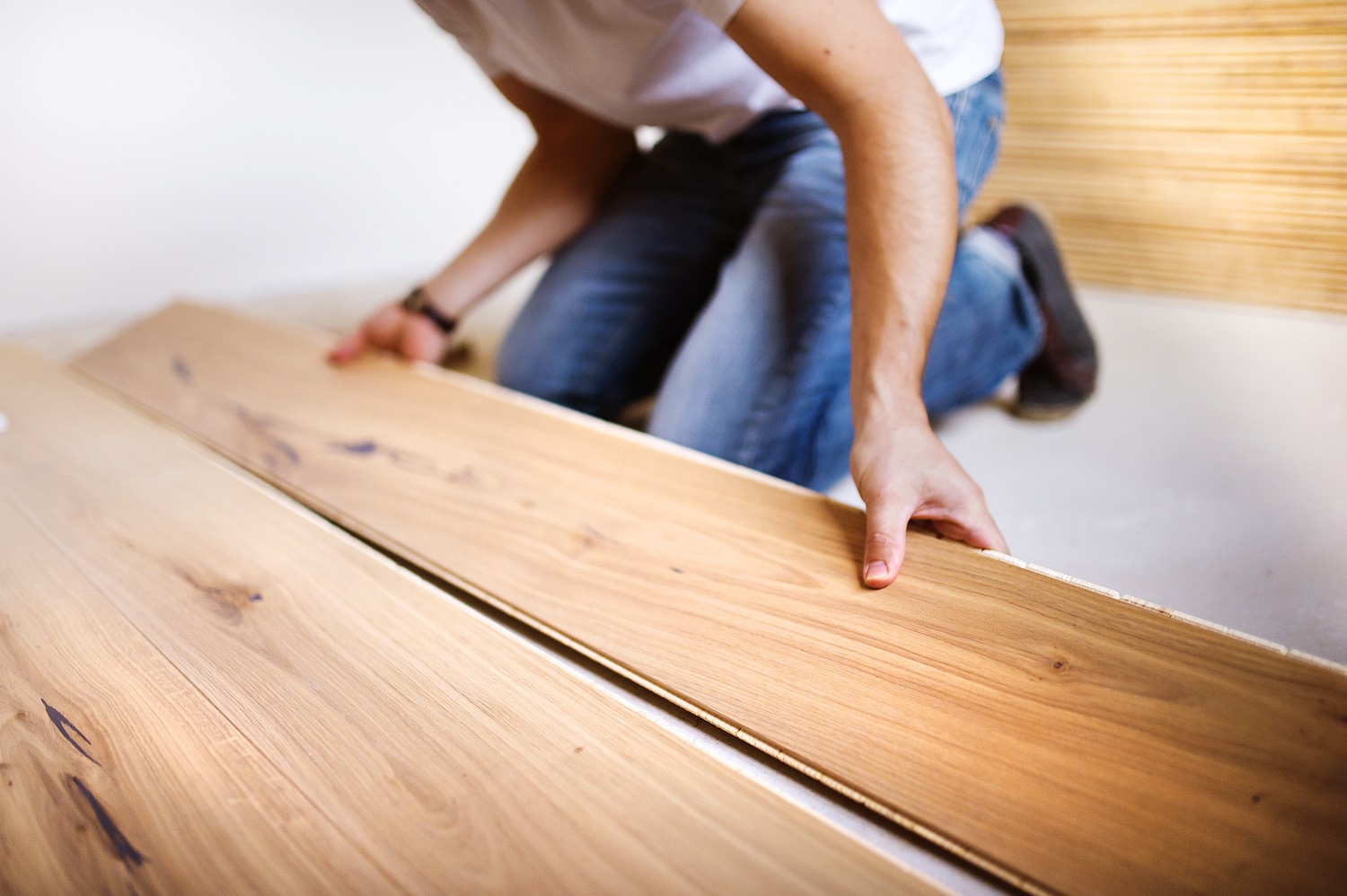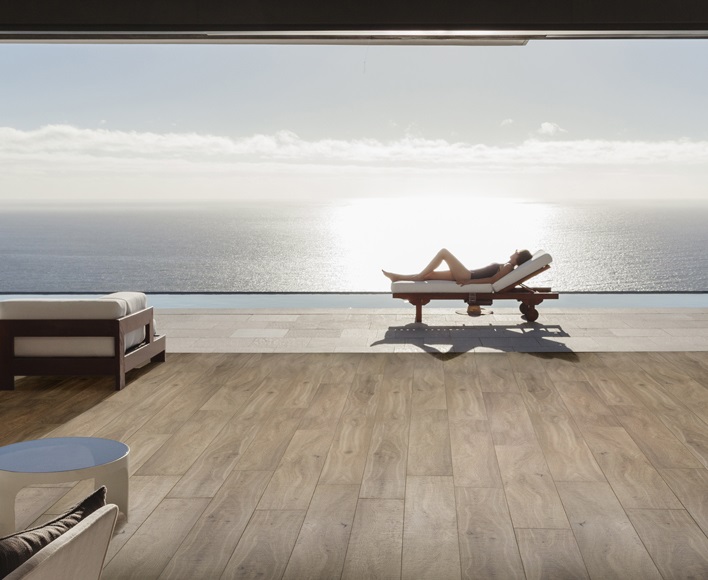Customers seeking a flooring option that mimics the look of timber at a more affordable price often find themselves trying to decide between laminate and engineered timber flooring. Because they look so similar, deciding between the two can be a difficult decision.
In this blog post, we’ll go over the key differences of each of these flooring options to help you choose the material that will be the best fit for your needs and space.
What Is Laminate Flooring?
Available in hundreds of colours and styles, laminate flooring is a popular option in the consumer market. Although some people still believe it is made out of plastic, laminate flooring is a hybrid, man-made material that consists of several layers:
- A fibreboard base (comprised of aggregated wood particles that are pressurised to form sheets)
- Photograhic image layer
- Transparent wear layer (a durable, thin layer of clear plastic to protect the image and base layer from exterior elements such as scratches and UV rays)
Thanks to ever-advancing technology, laminate floors look, feel, and perform better than ever before.
Laminate floors are an especially popular choice in dining rooms, bedrooms, hallways, kitchens, and other areas that are not at risk of excessive exposure to moisture.
What Is Engineered Hardwood Flooring?
Engineered wood, instead of being solid timber throughout, features a true timber layer over a base of high-quality plywood. Although engineered timber looks exactly like true timber flooring, it boasts additional benefits.
Engineered timber, an increasingly popular flooring choice, comes in almost any style and colour.
Laminate vs Engineered Flooring At a Glance
|
|
Laminate Flooring |
Engineered Timber Flooring |
|
Appearance |
Simulated timber appearance |
Real timber surface |
|
Cost |
Significantly more affordable than solid timber |
Only slightly more affordable than real timber |
|
Installation |
Floating floor with interlocking edges, can be glued down or snapped together |
Nail-down or glue-down types are most common |
|
DIY or Professional Installation |
Potential for DIY-friendly installation |
Profesional installation is recommended |
|
Resale Value |
Does not improve resale value |
Offers improved resale value |
|
Lifespan |
Typically around 10 to 20 years |
30 years or more |
Appearance
Although both types come in hundreds of styles and colours, engineered timber has the clear advantage when it comes to appearance.
Laminate flooring has seen significant technological advancements that allow it to better mimic hardwood flooring. Top-quality laminates feature richer colours, deeper embossed wood grain texture, and thicker planks that offer a more realistic look. However, laminate will always be a replica of real timber.
With a surface consisting of real hardwood, engineered timber will always outperform laminate when it comes to appearance, especially upon close-up viewing.

Laminate flooring, such as the Airstep Extravagant Dynamic XXL range, looks like real timber floors.
Water and Heat Resistance
Even when labelled “water-resistant”, laminate flooring’s fibrewood core is susceptible to moisture damage if any water seeps through the cracks between boards. However, laminate’s plastic surface layer does a great job of repelling water, as long as it gets cleaned up immediately.
Engineered wood flooring is typically finished with a waterproof, tough surface sealer. Still, the surface veneer and plywood base layers are wood, meaning they can warp and swell if they get wet.
Ultimately, neither engineered timber or laminate are ideal choices for damp, humid locations. Even with a well-sealed surface, cracks in laminate planks or engineered timber can let moisture seep through to the plywood or fibreboard core. This can lead to swelling, warping, and mould.
If you are looking for the best flooring for damp, humid rooms, luxury vinyl flooring or a laminate flooring specifically designed to protect against moisture may be better options.
Maintenance
With a plastic surface layer that can be easily wiped clean, laminate flooring is fairly low maintenance. Regular sweeping and occasional mopping is generally all it takes to care for either laminate or engineered timber floors. For both flooring types, it is imperative that any spills be wiped up immediately.
Wear and Tear
With a solid timber layer on top, engineered hardwood reacts to wear and tear as solid timber would, making dents, scratches, and dings a possibility. Laminate’s protective wear layer helps better protect it against damage compared to engineered timber.
If you plan to install the flooring in a high traffic area, laminate may be a better option. However, when it comes to wear and tear, it is important to take the next point into consideration.
Refinishing
Both laminate and engineered timber offer excellent durability. However, if it becomes badly damaged, laminate flooring cannot be refinished. Rather, it must be completely removed and replaced.
With a tough surface finish, engineered hardwood flooring can actually be sanded and refinished at least once during its lifetime, making it the better option in terms of overall durability and lifespan. There is a chance you may even be able to refinish it twice (possibly even three times).
Installation
Laminate flooring has the advantage of being one of the easier flooring materials to install. It features unique click-lock edges that help the planks interlock and float over underlayment and the subfloor, giving it the one-up on engineered timber if DIY installation is important to you. Most people report that it is possible to install laminate flooring in a room in an afternoon.
Although easier to install than solid timber, engineered hardwood floors are far more likely to require a professional tradesman for installation.
Installation typically involves blind-nailing the planks to the subfloor with staples or nails driven at an angle through the tongues along the board’s edges. Engineered timber may also come in floating versions or options that can be glued down over a concrete subfloor.

Engineered timber is often installed by a professional floor layer.
Cost
No tie here. Laminate flooring is the clear winner in terms of affordability. Not only is it cheaper per square metre, laminate also offers the advantage of potential DIY installation, meaning even bigger savings when compared to engineered hardwood.
Lifespan
Laminate flooring typically offers a 10 to 20 year lifespan, depending on how much wear it receives, how well it is maintained, and the quality of the flooring.
With added durability and the potential for refinishing, engineered hardwood can last 30 years or even longer.
Sizes
The sizes of these two flooring options are comparable. Laminate flooring typcially comes in planks that are around 8-18 cm wide and 120 cm long. Engineered timber boards are usually between 6-18 cm wide and 90-120 cm long.
Resale Value
High-quality laminate flooring is certainly not a drawback when it comes to marketing a home. However, it does not increase a home’s resale value.
Generally, engineered timber floors offer improved resale value compared to laminate flooring.
Comfort and Sound
Both engineered timber and laminate flooring are comfortable underfoot, but because laminate flooring usually “floats” over the subfloor, it may flex slightly underfoot. This is particularly true if the underlayment is not perfectly flat and smooth.
Pet nails and heels may also produce an annoying clicking sound on the surface. However, if installed over a foam underlayment, it can be a “softer” floor.
Since it is thicker and glued down, engineered hardwood does not have an issue with flexing. It may also feel a bit harder underfoot as it is unusual for engineered timber to be installed over a foam underlayment.
How Do I Decide Between Laminate and Engineered Timber?
Laminates have advanced to a point where they look like real timber flooring, but without the higher cost or extra maintenance. Engineered timber offers the exact look and feel of solid timber, but with increased durability and a possible increase in your home’s resale value.
To determine which flooring choice is best for your needs and space, consider the following questions:
- Where will the flooring be installed?
- How much traffic will the flooring get?
- Do you have kids or pets?
- How much maintenance are you willing to do?
- Will there be a lot of moisture in the room?
- What is my budget?
- How important is it to have the appearance of solid timber?
Still Need Help Deciding?
Engineered timber and laminate are both popular alternatives to timber flooring. While they do share some similarities, they are not created equal. Understanding their key differences will help you decide which option will be best in your home.
Are you still unsure of whether laminate or engineered hardwood is the best option for your home? We completely understand. Finding flooring you love — both in terms of appearance and performance — is vital to creating a home you love.
We are here to help you every step of the way to make sure you are completely happy with your new flooring. When you contact us, one of our expert team members would be glad to walk you through any questions you have on laminate flooring vs engineered flooring… or any and all other flooring questions!
Frequently Asked Questions About Laminate vs Engineered Timber Flooring
Both can work in kitchens with proper precautions. Laminate is more water-resistant on the surface, but the fiberboard core can swell if water seeps between boards. Engineered timber has a real wood surface that needs prompt spill cleanup. For kitchens, choose water-resistant laminate with tight-fitting joints or engineered timber with a quality sealant. Either way, use silicone to seal perimeter edges and be diligent about wiping up spills immediately.
Laminate typically performs better with pets and children. Its wear layer resists scratches from pet claws and is less likely to be dented by dropped toys. It's also easier to clean up accidents quickly. However, laminate can be noisier (clicking sounds from pet nails), while engineered timber feels more solid underfoot. If you choose engineered timber with active kids or pets, opt for a harder wood species with a matte finish that better hides scratches.
It depends on your priorities. Laminate can be half the price of engineered timber when you factor in both materials and installation (especially if you DIY install laminate). However, engineered timber adds resale value to your home, can be refinished at least once, and has a longer lifespan (30+ years vs 10-20 for laminate).
If you plan to stay in your home long-term or are concerned about resale value, engineered timber is worth the investment. For rental properties or shorter-term solutions, laminate offers better value.



